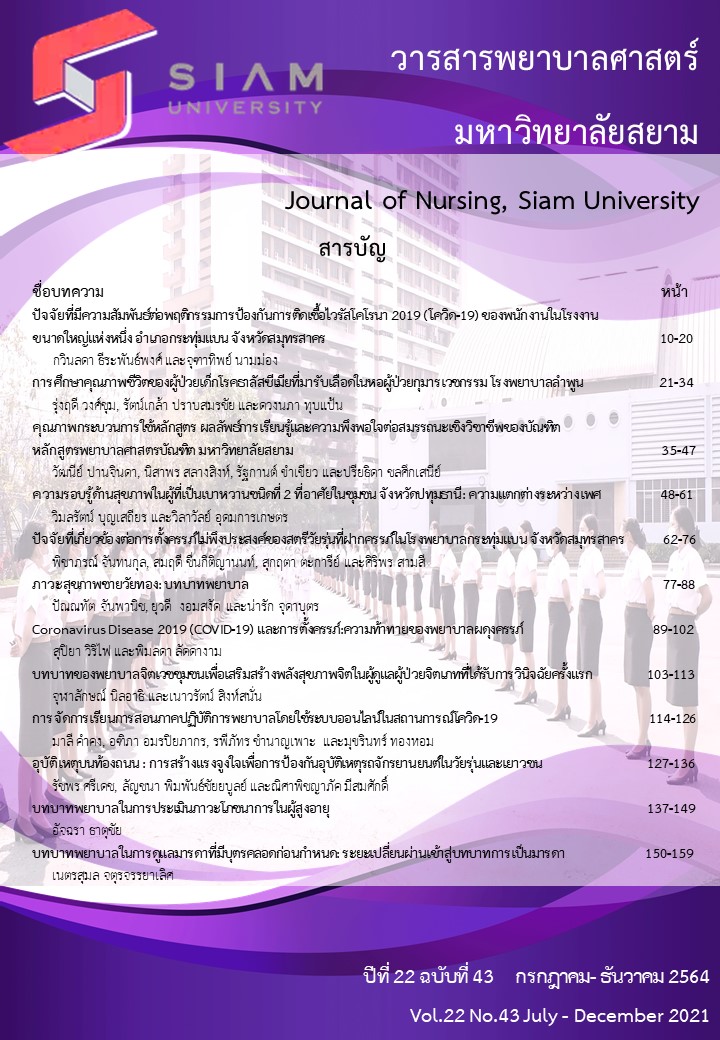การศึกษาคุณภาพชีวิตของผู้ป่วยเด็กโรคธาลัสซีเมียที่มารับเลือด ในหอผู้ป่วยกุมารเวชกรรม โรงพยาบาลลำพูน
คำสำคัญ:
คุณภาพชีวิต, เด็กโรคธาลัสซีเมียที่มารับเลือดบทคัดย่อ
การวิจัยครั้งนี้เป็นการวิจัยเชิงพรรณนาเพื่อศึกษาคุณภาพชีวิตของผู้ป่วยเด็กโรคธาลัสซีเมียที่มารับเลือดในหอผู้ป่วยกุมารเวชกรรม โรงพยาบาลลำพูน กลุ่มตัวอย่าง คือ ผู้ป่วยเด็กโรคธาลัสซีเมียอายุ 5-18 ปี ที่เข้ารับการให้เลือดที่หอผู้ป่วยกุมารเวชกรรม โรงพยาบาลลำพูน จำนวน 43 คน เก็บรวบรวมข้อมูล โดยใช้แบบวัดคุณภาพชีวิตเด็ก (PedsQLTM) คำนวณหาค่าความเชื่อมั่นด้วยสัมประสิทธิ์ของครอนบาค ได้เท่ากับ 0.89 วิเคราะห์ข้อมูลโดยใช้ความถี่ ร้อยละ ค่าเฉลี่ย และค่าเบี่ยงเบนมาตฐาน
ผลการศึกษา พบว่า คะแนนคุณภาพชีวิตโดยรวมของกลุ่มตัวอย่างอยู่ในระดับปานกลาง (Mean=67.47, S.D.=14.32) เมื่อจำแนกเป็นรายด้านพบว่า ด้านที่มีคะแนนเฉลี่ยมากที่สุด คือ คุณภาพชีวิตด้านสังคม (Mean=75.69, S.D.=20.78) รองลงมา คือ คุณภาพชีวิตด้านอารมณ์ (Mean=69.07, S.D.= 16.84) ด้านสุขภาพ/ร่างกาย (Mean=68.68, S.D.= 16.03) และคะแนนเฉลี่ยน้อยที่สุด คือ ด้านโรงเรียน (Mean=55.69, S.D.= 19.04)
ดังนั้นหน่วยงานที่เกี่ยวข้องควรมีการประสานงาน ส่งต่อข้อมูลการรักษาของผู้ป่วยเด็กโรคธาลัสซีเมียจากโรงพยาบาลสู่โรงเรียน เพื่อวางแผนการรักษาร่วมกัน ซึ่งจะช่วยลดจำนวนวันของการขาดโรงเรียนและพัฒนาคุณภาพชีวิตด้านการเรียนของผู้ป่วยเด็กโรคธาลัสซีเมียให้ดียิ่งขึ้น
เอกสารอ้างอิง
กาญจนา สรรพคุณ ผกาทิพย์ ปอยสูงเนิน และบุญสืบ โสโสม. (2554). คุณภาพชีวิตของเด็กวัยรุ่นตอนต้นโรคธาลัสซีเมีย: การศึกษาจากมุมมอง ด้านเพศภาวะ. วารสารวิชาการสมาคมสถาบันอุดมศึกษาเอกชนแห่งประเทศไทย (สสอท.), 17(2), 85-93.
จิตสุดา บัวขาว. (บรรณาธิการ). (2561). แนวทางการดูแลรักษาผู้ป่วยธาลัสซีเมียในเวชปฏิบัติทั่วไป. กรุงเทพ: สำนักงานกิจการโรงพิมพ์องค์การสงเคราะห์ทหารผ่านศึกในพระบรมราชูปถัมภ์.
พจนพร งามประภาสม 2563 การศึกษาคุณภาพชีวิตผู้ป่วยเด็กโรคโลหิตจางธาลัสซีเมียที่ต้องรับเลือดเป็นประจำ ที่โรงพยาบาลแพร่. วารสารโรงพยาบาลแพร่, 28(1), 12-26.
พชรพรรณ สาริสุต. (2562). คุณภาพชีวิตและความชุกของภาวะซึมเศร้าในผู้ป่วยเด็กโรคธาลัสซีเมียในศูนย์การแพทย์ปัญญานันทภิกขุ ชลประทาน. วารสารสาธารณสุขศาสตร์, 49(2), 200-209.
ภาสกร ศรีทพย์สุโข. (2557). คุณภาพชีวิตด้านสุขภาพของเด็กในโรงเรียนและผลกระทบจากโรคอ้วนและโรคภูมิแพ้. รายงานการวิจัย มหาวิทยาลัยธรรมศาสตร์.
ภูษณิศา มาพิลูน ปรีย์กมล รัชนกุล และวาริยา หมื่นสาม. (2559). ผลของโปรแกรมการพัฒนาความสามารถในการดูแลตนเองของเด็กวัยเรียนโรคธาลัสซีเมียและความสามารถในการดูแลเด็กของผู้ดูแลต่อพฤติกรรมการดูแลตนเองของเด็ก. วารสารสภาการพยาบาล, 31(2), 52-68.
มาลัย ว่องชาญชัยเลิศ สารภี ด้วงชู และสุดารัตน์ คชวรรณ. (2557). คุณภาพชีวิตของผู้ป่วยเด็กโรคธาลัสซีเมียที่ต้องรับเลือดประจำที่โรงพยาบาลสงขลานครินทร์. สงขลานครินทร์เวชสาร, 32(6), 353-363.
เรืองฤทธิ์ โทรพันธ นฤมล ธีระรังสิกุล ศิริยุพา สนั่นเรืองศักดิ์ (2558) ปัจจัยที่มีความสัมพันธ์กับการจัดการอาการรบกวนของเด็กโรคธาลัสซีเมียที่ได้รับยาขับเหล็ก. วารสารวิทยาลัยพยาบาลบรมราชชนนี นครราชสีมา, 23(2), 32-46.
โรงพยาบาลลำพูน. (2559). รายงานประจำปี 2559. ลำพูน: โรงพยาบาลลำพูน. (อัดสำเนา).
วิปร วิประกษิต. (2556). “ธาลัสซีเมีย”: การรักษาโรคโลหิตจางธาลัสซีเมียแบบบูรณาการ. วารสารโลหิตวิทยาและเวชศาสตร์บริการโลหิต, 23(4), 303-320.
ศิริยุพา สนั่นเรืองศักดิ์ นฤมล ธีระรังสิกุล และพจนารถ สารพัด. (2563). ปัจจัยทำนายพฤติกรรมการจัดการตนเองของเด็กที่ป่วยด้วยโรคธาลัสซีเมีย. วารสารสถาบันบำราศนราดูร, 14(3), 146-157.
สมร ยอดพินิจ. (2560). ความสัมพันธ์ระหว่าง ปัจจัยคัดสรร การรับรู้ภาวะสุขภาพ และ พฤติกรรมการดูแลตนเองของเด็กป่วยโรคธาลัสซีเมีย. วารสารวิทยาลัยพยาบาลบรมราชชนนี กรุงเทพ, 33(1), 141-150.
สุวัฒน์ มหัตนิรันดร์กุล ปริทรรศ ศิลปกิจ และวนิดา พุ่มไพศาลชัย. (2541). คุณภาพชีวิตของคนไทยในภาวะวิกฤตเศรษฐกิจ. ทุนสนับสนุนจากกรมสุขภาพจิต โรงพยาบาลสวนปรุง จังหวัดเชียงใหม่.
Boonchooduang, N., Louthrenoo, O., Choeyprasert, W. & Charoenkwan, P. (2015). Health related quality of life in adolescents with thalassemia. Pediatric Hematology and Oncology, 32(5): 341-348.
Duangchu, S., Wongchanchailert, M. & Khotchawan, S. (2014). Quality of life in children with transfusion-dependent thalassemia at Songklanagarind Hospital. Songklanagarind Medical Journal, 32(6), 353-363.
Hockenberry, M.J. & Wilson, D. (2015). Wong’s nursing care of infants and children (10th ed). St. Louis: Missouri.
Nutbeam, D. (2009). Defining and measuring health literacy: What can we learn from literacy studies? International Journal of Public Health, 54(5), 303-305. doi: 10.1007/s00038-009-0050-x.PMID: 19641847.
Thavorncharoensap, M., Torcharus, K., Nuchprayoon, I., Riewpaiboon, A., Indaratna, K. & Ubol, B. (2010). Factors affecting health-related quality of life in Thai children with thalassemia. BMC Blood Disorders, 10(1). doi:10.1186/1471-2326-10-1.
Sharma, S., Seth, B., Jawade, P., Ingale, M. & Setia, M.S. (2017). Quality of life in children with thalassemia and their caregiver in India. Indian Journal of Pediatrics, 84(3), 188-194.
Sritipsukho, P., Wisai, M. & Thavorncharoensap, M. (2013). Reliability and validity of the Thai version of the Pediatric Quality of Life Inventory 4.0. Quality of Life Research, 22(3), 551-557.
Varni, J.W., et al. (2001). The PedsQL™ 4.0: Reliability and validity of the Pediatric Quality of Life Inventory™ Version 4.0 Generic Core Scales in healthy and patient populations. Medical Care, 39(8), 800-812.
Varni, J.W., Seid, M. & Rode, C.A. (1999). The PedsQL 4.0: measurement model for the pediatric quality of life inventory. Medical Care, 37(2), 126-139.
Wongsin R. (2011). The quality of life in patients with thalassemia at Queen Sirikit National Institute of Child Health (Thai). Thesis for the Diploma of Thai Board of Pediatrics. Bangkok: The Medical Council of Thailand.
ดาวน์โหลด
เผยแพร่แล้ว
รูปแบบการอ้างอิง
ฉบับ
ประเภทบทความ
สัญญาอนุญาต
เนื้อหาและข้อมูลที่เผยแพร่ในวารสารพยาบาลศาสตร์ มหาวิทยาลัยสยามถือเป็นข้อคิดเห็นและความรับผิดชอบของผู้นิพนธ์บทความโดยตรง
บทความ เนื้อหา ข้อมูล รูปภาพ ฯลฯ ที่ได้รับการเผยแพร่ในวารสารพยาบาลศาสตร์ มหาวิทยาลัยสยาม ถือเป็นลิขสิทธิ์ของวารสารพยาบาลศาสตร์ มหาวิทยาลัยสยาม หากบุคคลหรือหน่วยงานใดต้องการนำทั้งหมดหรือส่วนหนึ่งส่วนใดไปเผยแพร่หรือเพื่อกระทำการใด ๆ จะต้องอ้างอิงวารสารพยาบาลศาสตร์ มหาวิทยาลัยสยามทุกครั้ง



